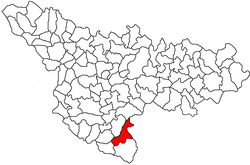Gătaia
|
Gătaia Gattaja Gátalja |
||||
|
||||
| Basic data | ||||
|---|---|---|---|---|
| State : |
|
|||
| Historical region : | Banat | |||
| Circle : | Timiș | |||
| Coordinates : | 45 ° 25 ' N , 21 ° 26' E | |||
| Time zone : | EET ( UTC +2) | |||
| Height : | 110 m | |||
| Area : | 247.48 km² | |||
| Residents : | 5,861 (October 20, 2011) | |||
| Population density : | 24 inhabitants per km² | |||
| Postal code : | 307185 | |||
| Telephone code : | (+40) 02 56 | |||
| License plate : | TM | |||
| Structure and administration (as of 2016) | ||||
| Community type : | city | |||
| Structure : | 5 districts / cadastral communities: Butin , Percosova , Sculia , Șemlacu Mare , Șemlacu Mic | |||
| Mayor : | Raul Cozarov ( PNL ) | |||
| Postal address : | Carpați Street, no. 106 loc. Gătaia, jud. Timiș, RO-307185 |
|||
| Website : | ||||
| Others | ||||
| City Festival : | July | |||
Gătaia ( German Gattaja , Hungarian Gátalja ) is a small town in Timiș County , Banat , Romania .
Geographical location
Gătaia is located in the Banat , to the left of the Bârzava River . The district capital Timișoara is located about 40 km northwest.
Neighboring places
| favorite | Sacoșu Turcesc | Tormac |
| Birda |

|
Berzovia |
| Denta | Jamu Mare | Bocșa |
history
Gătaia was first mentioned in 1323 under the name Gothal . At that time the place belonged to the Kingdom of Hungary . In the 16th century, the Ottomans gained control of the region. In 1718, through the Peace of Passarowitz, the Banat and with it Gătaia came to Austria-Hungary . As a result, as in many places in the Banat, members of various nationalities settled there, including numerous Germans. In 1823 the Hungarian writer László Govore received the place as a gift. As a result of the Treaty of Trianon in 1920, Gătaia came to Romania. The place became a local administrative center in 1935.
As a result of the Waffen-SS Agreement of May 12, 1943 between the Antonescu government and Hitler's Germany , all men of German origin who were conscripted into the German army. Before the end of the war, in January 1945, all ethnic German women between the ages of 18 and 30 and men between the ages of 16 and 45 were deported to the Soviet Union for reconstruction work .
The Land Reform Act of March 23, 1945 , which provided for the expropriation of German farmers in Romania, deprived the rural population of their livelihoods. The expropriated land was distributed to smallholders, farm workers and colonists from other parts of the country. The collectivization of agriculture was initiated in the early 1950s . Through the nationalization law of June 11, 1948 , which provided for the nationalization of all industrial and commercial enterprises, banks and insurance companies, the expropriation of all economic enterprises took place regardless of ethnicity.
Since the population along the Romanian-Yugoslav border was classified as a security risk by the Romanian government after the rift between Stalin and Tito and his exclusion from the Cominform alliance, "politically unreliable elements" were deported to the Bărăgan on June 18, 1951 . Steppe regardless of ethnicity. At the same time, the Romanian leadership aimed to break the resistance against the impending collectivization of agriculture. When the Bărăgan abductees returned home in 1956, the houses and farms expropriated in 1945 were returned to them. However, the field ownership was collectivized.
After the Second World War, the number of German residents decreased due to flight and emigration to Germany; In return, Romanians immigrated from other parts of the country. In 2004 Gătaia received city status.
The most important branches of the economy are agriculture, trade, textile and food industries.
population
In 1880 there were 6,285 inhabitants registered in the area of today's city, including 2,756 Romanians , 1,551 Hungarians , 1307 Germans , 463 Slovaks and 89 Serbs . As early as 1910, the maximum population was registered with 8912, which then tended to decline again. At the 2002 census there were 6155 people in the community, including 4565 Romanians, 937 Hungarians, 441 Slovaks, 104 Germans, 61 Roma , 38 Serbs and 12 Czechs . 4073 lived in the actual city, 2082 in the five incorporated villages.
traffic
Gătaia is a regional railway junction and is located on the routes from Timișoara to Reșița and from Buziaș to Jamu Mare . Both lines are served by the private provider Regiotrans . The national road Drum național 58B runs through the city from Voiteg to Reșița.
Attractions
- Săraca Monastery (15th century) in the Șemlacu Mic district
photos
See also
literature
- Elke Hoffmann, Peter-Dietmar Leber and Walter Wolf : The Banat and the Banat Swabians. Volume 5. Cities and Villages , Media Group Universal Grafische Betriebe München GmbH, Munich, 2011, 670 pages, ISBN 3-922979-63-7 .
Web links
Individual evidence
- ↑ 2011 census in Romania at citypopulation.de
- ↑ Mayoral elections 2016 in Romania ( MS Excel ; 256 kB)
- ^ Banat News, accessed on February 15, 2009 ( Memento from April 30, 2009 in the Internet Archive )
- ↑ 2002 census, accessed on May 4, 2009 (PDF; 982 kB)




